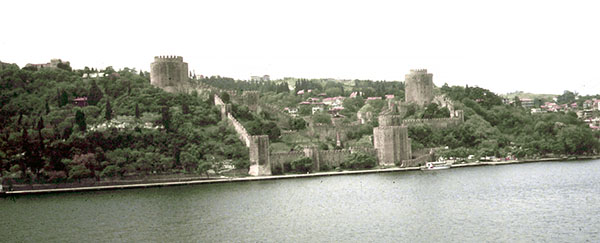As the Western Roman empire disintegrated in the fifth century CE, Roman civilization continued to flourish, lasting as the Byzantine Empire in the Eastern Mediterranean for another thousand years. Centered on Constantinople--named for Constantine--aka New Rome, the Eastern Roman Empire existed as a unique mix of Roman law and urban life, Christianity, Greek culture and language, and a cosmopolitan population. As the dominant culture of the Eastern Mediterranean, Byzantine Rome distinctly shaped the politics, economies, religions and cultures of the newly-emerging states and societies in Eastern Europe, Russia and Anatolia. As such, Russia inherited a civilization much more directly linked to the Greek-speaking (and Orthodox Christian) world than to the Latin West. Russia also became the frontier/border between Europe and Asia.
The Byzantine empire developed very effective military and diplomatic techniques that helped to ensure its long survival. In fact, the adjective "Byzantine" is often used to connote enormous complexity, as in "Byzantine" diplomacy. It refers to the complexities of constant palace revolutions, coups and murders over the centuries that made dealing with Byzantine officials an extremely difficult matter.
Some things to consider about Byzantine civilization
330 CE (the move by Constantine the of his capital to the east) - 1453 (fall of the city to the Ottoman Turks); that is still an extremely long period of time, over one thousand years for that empire to exist.
The inhabitants of the Byzantine Empire considered themselves Romans and continued to refer to themselves as Romans, even though they mostly spoke Greek and not Latin.
This was a theocratic state in which the emperor dominated the church (caesaro-papism = the head of state is also master of the church), and this was different from the situation in the west where the pope was powerful.
The emperor was, for all intents and purposes, a dictator; he made law, and there was no longer a senate. The emperor was all powerful yet anybody could rise to become emperor--it was very, complicated the machinations behind control of the throne. Wikipedia has a nice, short explanation of the emperor's titles.
Like the empire in the west, this was a polyglot empire of Greeks, Syrians, Persians, Jews, Christians, Slavs (like the Bulgars) and many others - religion was the unifying force.
The economy and trade prospered for so long, and that's what enabled the empire to maintain a small, professional, highly trained army equipped with some really high technology for the time (like the signal mirrors). The government maintained a monopoly on silk production and purple dye, which also contributed to the wealth. After the breakdown of the monetary economy of the empire in the fourth century CE, The Byzantines were able to re-establish money with their gold coin known as the nomisma aka solidus).
Urban life continued to be vibrant in the east with Constantinople reaching an estimated population of half a million.
Religion was important in the east and included two important controversies. 1st, there was the iconoclasm controversy over the use of images and icons in the church and the role of those images. Was the miracle-working power embedded in the icon itself or was it in the image represented by the icon? Should an icon be venerated or adored? 2nd, the Great Schism occurred in which Christianity split into the wester, catholic church (centered in Rome and headed by the pope) and the eastern, orthodox church (headed by autonomous patriarchs).
Some differences contributing to the church split (the Great Schism of 1054)
1. In the east patriarchs were named by the emperor who controlled the church.
2. By the 800s CE, the church in the east had rejected papal authority.
3. the iconoclasm controversy
4. the race between the pope and the eastern patriarchs to convert the Bulgars
5. cultural differences, for example, Latin-speaking vs. Greek-speaking
6. The 1054 split centered over different wording (in the Greek and Latin versions) of the creed, the statement of faith in the church. There were other issues that fueled disagreements between east and west. The dispute grew heated, and representatives of Pope Leo 9 (1002-54) and patriarch Michael I Cerularius (1000-59) excommunicated each other
7. Church relations between the catholic west and orthodox east took a nose dive after that.
The decline of the Byzantine Empire began in the eleventh century. The economy faltered; the Crusades began; the Ottoman Turks made inroads eventually expanding all around Constantinople and into the Balkans, virtually isolating the city. On 29 May 1453, Constantinople fell to the Turks, thus ending the Roman empire.
![]()
Some recommended online lectures and websites
- Byzantine Empire
- History of the Byzantine Empire
- The Reign of Justinian
- Hagia Sophia: The Deesis Mosaic According to Bridget Byrne, "Hagia Sophia, also sometimes referred to as Santa Sophia, is the greatest monument of Byzantine architecture. It was originally built by the Emperor Constantius in 360 and later rebuilt as a masterpiece of Justinian's. The small, single picture in our course book does not even begin to show the mosque's true beauty. The following website gives a more detailed history and includes extravagant pictures of the mosque including the first representation of Christ mosaic which is said to be among the greatest treasures of world art and culture. This Byzantine art dates from somewhere between 1185-1204 and was first revealed beneath layers of plaster on July 14, 1934. Not much of the mosaic remains but the faces of Christ, his mother, and St. John the Baptist. This website offers a great history of both Byzantine architecture and the how the Byzantine mosaics were made." I found this website to be very fascinating and I believe many others will consider the same.
- For extra credit please suggest to your instructor a relevant website for this unit of the course. Send the title of the site, the URL and a brief explanation why you find the information interesting and applicable to the material being studied in this unit.
